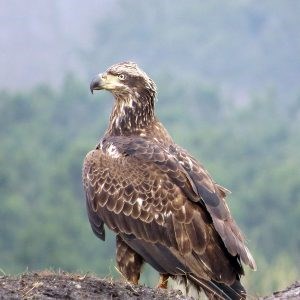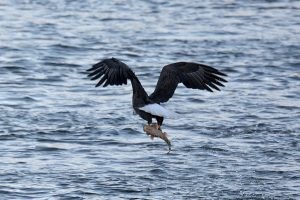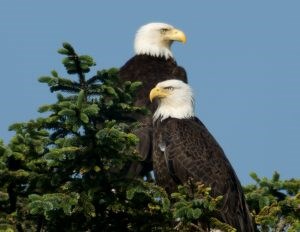This content was originally published by the Longmont Observer and is licensed under a Creative Commons license.
Majestic and graceful, a national symbol has found its way to Longmont. Bald eagles here? Yes, that’s right! For the past couple of weeks, I’ve been seeing a pair of bald eagles around Union Reservoir. One day, I even saw one perched on a light post near the Safeway at 17th and Pace.
Once nearly extinct, bald eagles have made an amazing recovery. The bald eagle was listed as an endangered species in 1978 when a combination of trapping, shooting, poisoning, and DDT-related reproductive failures took a toll on the population. By the late 1990s, breeding pairs of bald eagles were found once again throughout the United States and in 2007, they were removed from the Endangered Species List. They can be found throughout Colorado year-round.
Adult bald eagles are easily recognizable with their iconic white heads and tails and dark brown body. The legs and bills of the adult are bright yellow. Immature bald eagles are harder to recognize, however. Their size is one clue that will help you recognize them. They mostly have dark heads and tails with the wings and body being mottled with white. Immature bald eagles will not get adult plumage until they are about four or five years old.
Bald eagles are much larger than the other raptors around Longmont. In flight, they hold their wings flat. On the ground, they walk with an awkward rocking gait. Bald eagles are even capable of floating on the water and will use their wings to “row” when the water is too deep for walking. Females are larger than males and weigh between 10-14 pounds, whereas males weigh 8-9 pounds. Bald eagles are 31-37 inches long and have a wingspan between six and seven and a half feet!

Bald eagles can typically be found close to water, but may also be found in open habitats. Because they are found throughout the United States, habitats can vary from desert rivers, swamps, and coniferous forests. During the winter, you may find eagles congregating in large groups called convocations. Although we usually think of bald eagles in these places, you can even find them raiding dumpsters in Alaska. They prefer to perch in tall trees that offer a good view of the surrounding area.
Bald eagles eat primarily fish, but do hunt other animals such as mammals, reptiles, amphibians, waterfowl and gulls. Surprisingly, bald eagles also scavenge for food a fair amount, harassing other birds for their prey or by eating dead animals and garbage. They have been known to grab fish out of an osprey’s talons while in midair. Even people and mammals have been victims of the bald eagle’s scavenging. They may gorge themselves on prey and digest it over several days. The bald eagle is also capable of fasting for many days, sometimes weeks. Bald eagles either hunt by perching in a tree and swooping down on their prey or by flying low over the ground.

Bald eagles have amazing courtship displays. In one such display, the male and female will lock talons while high in the sky and spiral downward in a cartwheeling motion. At the last minute, they will break off so that they don’t crash into the ground. They may also fly to a high altitude and plunge back to the earth with their wings folded, pulling up at the last second. Bald eagles don’t mate until they are four or five years old, and they are monogamous for life.
In Colorado, bald eagles typically nest in cottonwood trees, but will also use other tall trees or nest on cliffs. They will begin building their nests one to three months prior to laying eggs. Nests are often constructed on dead limbs because this offers the pair an unobstructed view. Both the male and the female bring nesting materials to the nest site, but the female is the one who places most of the material. Sticks are woven together and cracks are filled with soft materials such as grass, moss, or cornstalks. The nest is lined with soft, woody material and down. The finished nest is usually four to five feet across, but may be up to seven feet across and two to four feet tall. Nests may be reused year after year.
Female bald eagles lay one to three white eggs. Both the male and the female incubate the eggs for 34-36 days, but the female does most of the incubating. There is only one clutch per season although renesting may occur if a clutch is destroyed. Males and females are very careful not to break the eggs, and will walk with clenched feet to avoid piercing the eggs with their talons.

The young are covered in a light grey down when they hatch. For the first two weeks, there is a parent present with the young at all times. The female spends more time with the young than the male does. Both parents feed the young by bringing prey to the nest and tearing it into pieces which are then fed directly to the young. Around three weeks after hatching, the young will begin to peck at the food that is dropped in the nest. The young are able to fly around ten weeks of age.
An interesting fact, Benjamin Franklin did not want the bald eagle as the national emblem because of their tendency to steal food from other birds and because small birds will attack or mob them. He is quoted as saying “I wish the Bald Eagle had not been chosen the Representative of our Country. He is a Bird of bad moral Character. He does not get his Living honestly. … Besides he is a rank Coward: The little King Bird not bigger than a Sparrow attacks him boldly and drives him out of the District.”
Look skyward and in tall trees the next time you are near a body of water. You may see a bald eagle. You can also listen for their song which is really a series of squeaky cackling and squeals. Enjoy the sight of this magnificent bird that has made such a comeback. After all, it very nearly wasn’t our national symbol.


